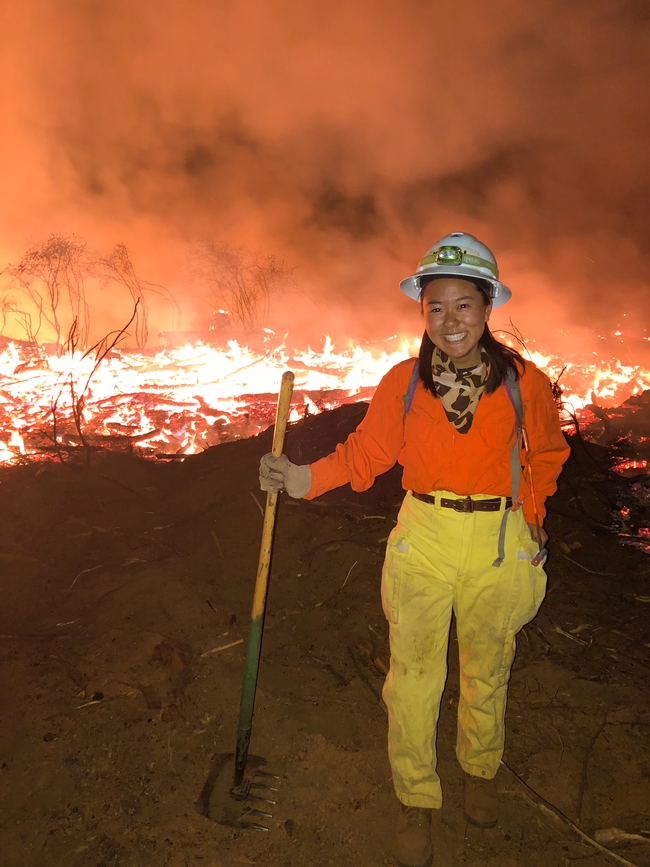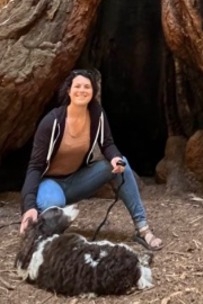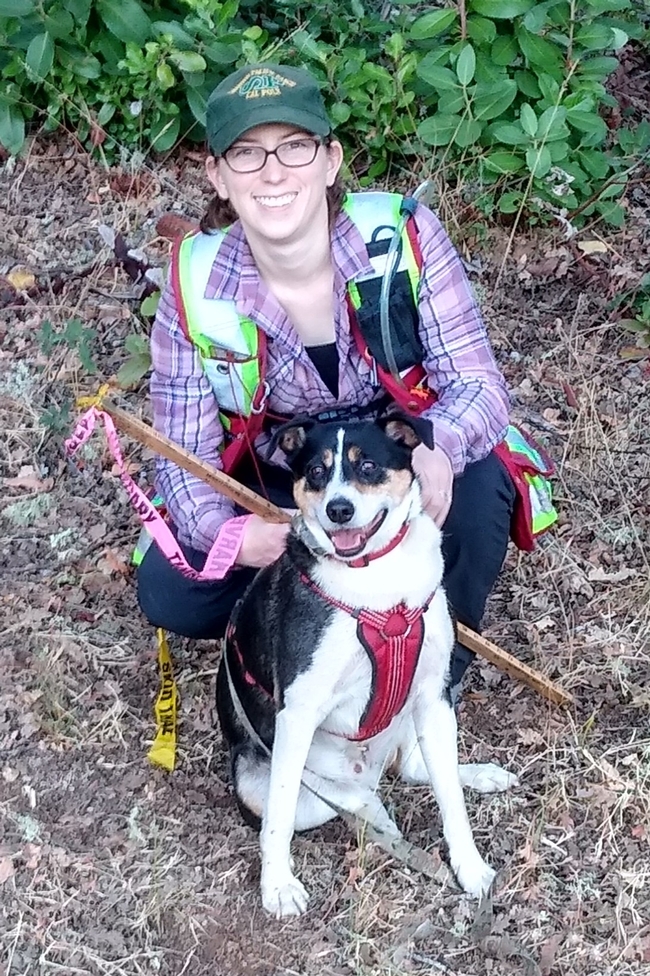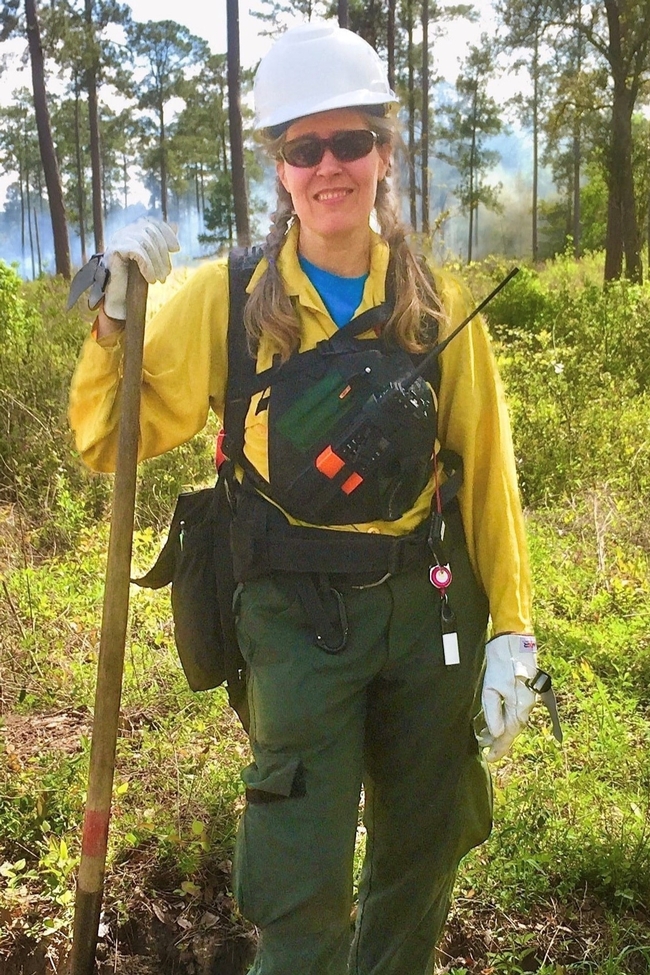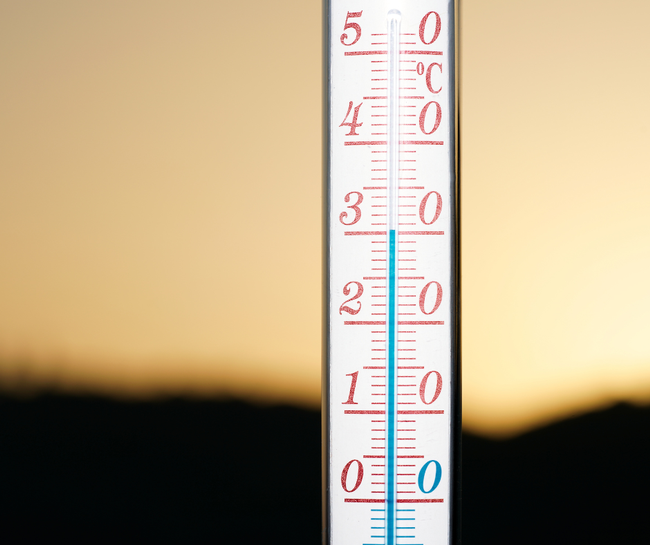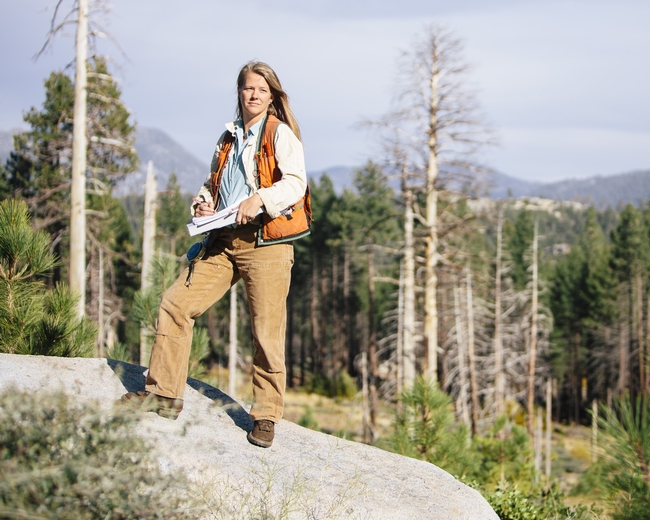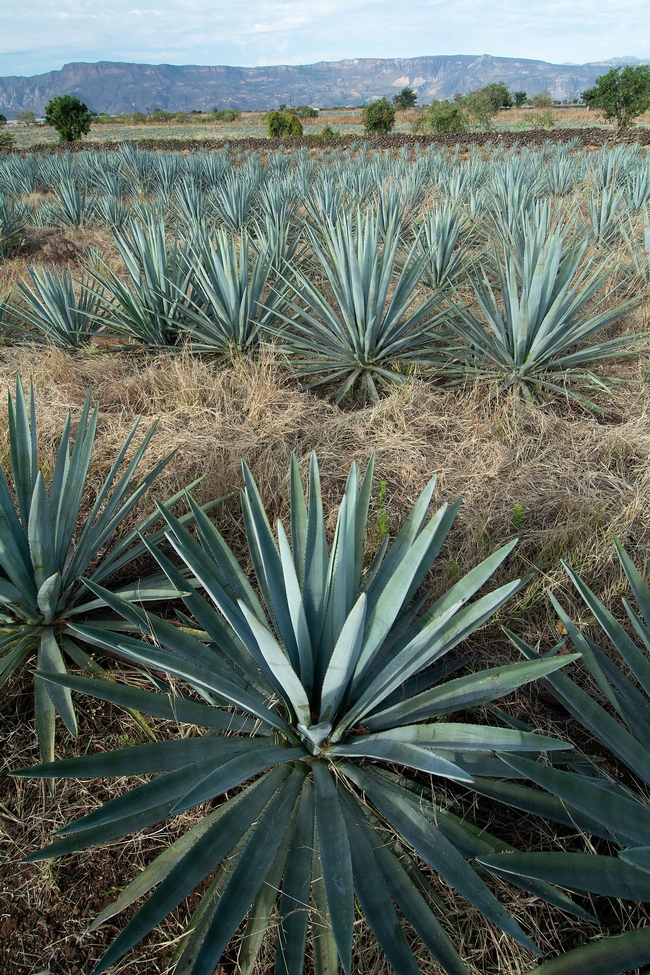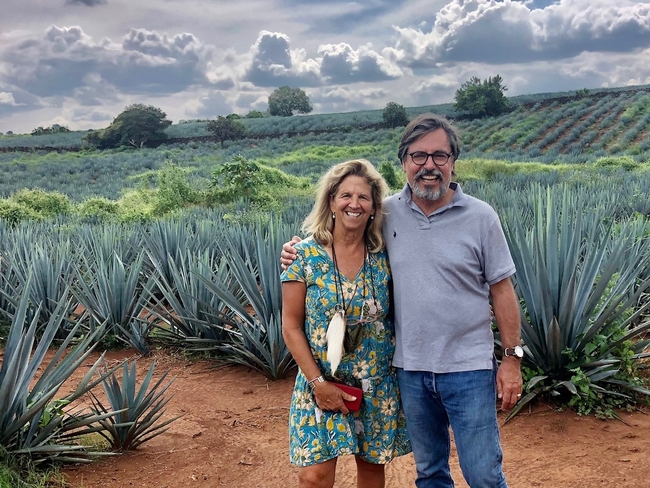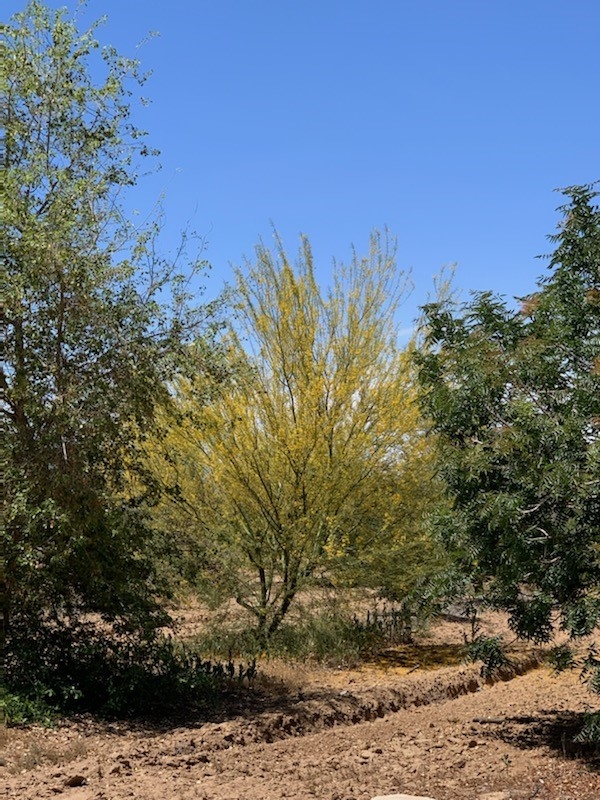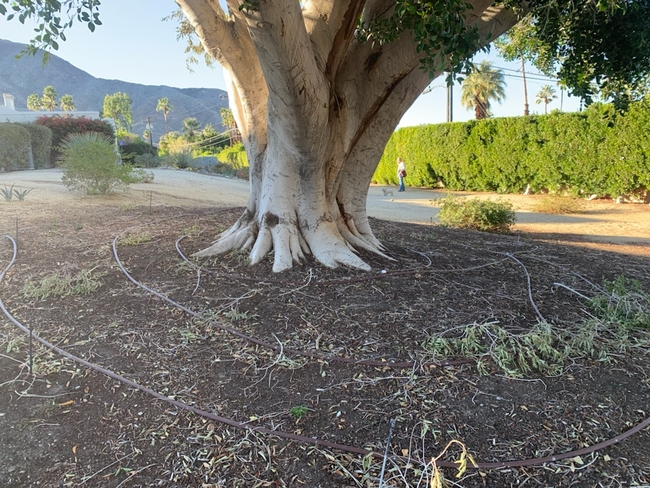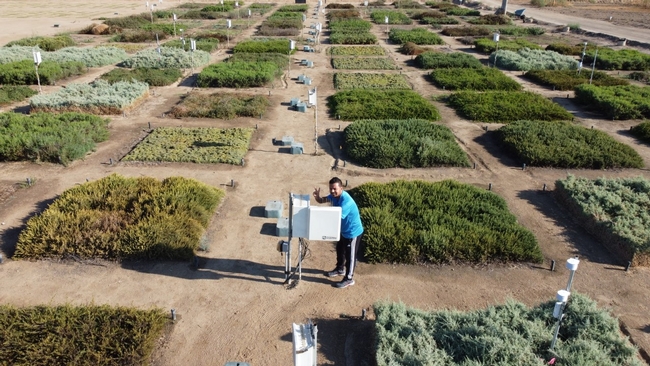Drought Blog RSS
New advisors share crucial wildfire expertise
UC ANR hires more fire advisors to address growing threat to California communities
Bringing more expertise to more places across the state, University of California Agriculture and Natural Resources continues to hire fire advisors to help communities prepare for one of the most devastating climate-fueled threats.
With wildfires a constant danger as drought grips California, five highly skilled UC Cooperative Extension experts have joined the organization since early May:
- Katie Low, statewide fire coordinator (and also serving Nevada and Placer counties)
- Alison Deak, fire advisor serving Mariposa, Fresno and Madera counties
- Tori Norville, fire advisor serving Sonoma, Napa and Marin counties
- Barb Satink Wolfson, fire advisor serving Monterey, San Benito, Santa Clara and Santa Cruz counties
- Luca Carmignani, fire advisor serving Los Angeles and Orange counties
These positions – as well as other recent additions in agriculture and natural resources fields – are made possible by California's commitment, as reflected in the state budget, to improve the lives of residents in the face of a changing climate.
This robust team of fire experts provide broad knowledge and practical advice on a wide range of topics, including fire hazard mitigation, fire ecology, prescribed fire, wildland fire research, forest and wildlife management, and climate change effects.
Although their specific areas of expertise vary, all the new fire advisors are dedicated to helping residents and community groups across California become more fire-aware, adapted and resilient. They share vital information on how Californians can prepare homes, landscapes and property for wildfire.
Katie Low
Katie Low, who began as the University of California Cooperative Extension statewide fire coordinator on Sept. 1, will fulfill two important functions for UC Agriculture and Natural Resources' team of fire experts.
First, she will coordinate and partner with UCCE fire advisors throughout California to develop and deliver wildfire-related science and outreach materials for a wide range of communities across the state. Low said encouraging diversity in the network of fire experts and engaged communities will be crucial.
“One of my goals is to help build and maintain a diverse and inclusive community of fire and natural resource professionals,” she said.
Based at the UCCE office in Auburn, Low also will collaborate with local natural resource professionals and residents in Nevada and Placer counties on projects that bolster community and ecosystem resilience to wildfire and climate change.
“I look forward to working with community groups, land managers and scientists to implement viable fire-resilient management strategies for ecosystems in the region and statewide,” Low said.
Equipped with bachelor's degrees in geography and ecosystems management and forestry, as well as a master's in forestry, all from UC Berkeley, Low brings to UC ANR a wealth of knowledge and a variety of experience.
As a fire and forest ecologist, she studied the impacts of fuels-reduction and forest-restoration treatments on Sierra Nevada mixed-conifer forests. Low also worked as operations coordinator for the California Outdoor Engagement Coalition, and as a forestry aide for California Department of Forestry and Fire Protection's Forest Biometrics Program.
Low can be reached at 530-889-7385 and katlow@ucanr.edu; follow her on Twitter @lowseverityfire.
Alison Deak
Alison Deak joined UC Cooperative Extension in August 2022 as a fire advisor for Mariposa, Fresno and Madera counties. Since she began work, Deak has been focused on conducting a needs assessment and building rapport with community leaders.
Her role as fire advisor will include promoting the use of prescribed fire to help restore fire adapted landscapes. She will also prioritize community education, applied research and partnership building efforts that are based on scientifically informed ways to help communities mitigate, prepare for, and recover from wildfire.
Originally from northeast Ohio where there are no wildfires according to Deak, it was not until she moved to Colorado for college that she learned of their impact.
When the 2012 Waldo Canyon Fire occurred, Deak felt like her playground was burning down so she acted. She began volunteering with the wildfire recovery effort and her career into fire science took off from there.
Deak earned a bachelor's in geography and environmental studies from the University of Colorado in Colorado Springs and master's degrees in geography and nonprofit management from the University of Oregon.
Before moving to California and joining UC ANR, Deak worked as a wildland firefighter with the United States Forest Service and Bureau of Land Management.
When asked what she is looking forward to most, Deak shared that she is passionate about increasing diversity in the fire science field and, particularly, empowering more women to join. She is eager to help community members prepare for wildfire and mitigate fire risk in a safe and competent manner.
Deak is located at the UC Cooperative Extension office in Mariposa County and can be reached at aldeak@ucanr.edu.
Tori Norville
Tori Norville started on Aug. 1 as the new UC Cooperative Extension fire advisor for Sonoma, Napa and Marin counties.
In this capacity, Norville will work with residents and organizations within the wildland-urban interface to encourage and cultivate fire-adapted communities. She aims to provide education and outreach on home hardening, defensible space and the importance of forest and fuel management on the landscape.
While pursuing her bachelor's degree in forestry and natural resources at Cal Poly San Luis Obispo, Norville became interested in “disturbance ecology” – how factors such as disease, insects and fire affect landscapes and environments.
“Many of the forest health problems we are seeing are stemming from a lack of disturbance, which traditionally was fire,” Norville said.
Her understanding of fire and its effects deepened during her master's degree studies in forestry science (also at Cal Poly SLO), as well as through her seven years with CAL FIRE at the Jackson Demonstration State Forest in Mendocino County. She worked as the Registered Professional Forester for its Timber Sales Program, and then the Research and Demonstration Program.
Norville's firsthand experiences from the past few fire seasons have helped shape her goals and approach. She hopes to “work holistically with disturbances” – specifically fire – on the landscape to foster healthy forests and ecosystems that are adaptable and resilient, while also researching the environmental and social aspects of fuel-reduction projects and prescribed fire.
“Hopefully, I can begin to change the perception of fire from something we need to fear, to something we respect,” she said.
Norville, based at the UCCE office in Santa Rosa in Sonoma County, can be reached at trnorville@ucanr.edu.
Barb Satink Wolfson
Barb Satink Wolfson began in her role as UC Cooperative Extension fire advisor for Monterey, San Benito, Santa Clara and Santa Cruz counties on June 30.
Her primary responsibilities include wildland fire-related research and outreach for the Central Coast region, while building trust, strong partnerships and collaborative relationships within both professional and non-professional communities.
Satink Wolfson earned her B.S. and M.S. in forestry from Northern Arizona University, and brings to UC ANR more than 20 years of fire-research and outreach experience in Arizona. Her favorite job, though, was working as a backcountry ranger in Yosemite National Park during her undergraduate years.
In her new role, Satink Wolfson hopes to address some of the questions behind the use of prescribed fire in a variety of ecosystems (such as coastal prairies and oak woodlands), and help all Central Coast communities build resilience to wildland fire so residents can live safely within fire-adapted landscapes.
Satink Wolfson, based at the UCCE office in Hollister, can be reached at bsatinkwolfson@ucanr.edu.
Luca Carmignani
Luca Carmignani joined UCCE as a fire advisor for Orange and Los Angeles counties May 2. His research interests include image analysis, computer programming and scientific outreach.
Prior to joining UC ANR, Carmignani was a postdoctoral researcher in the Berkeley Fire Research Lab at UC Berkeley. His research has focused on fire and combustion applications, from wildland fires to material flammability.
He earned his Ph.D. in engineering sciences from the joint doctoral program between UC San Diego and San Diego State University after obtaining his bachelor's and master's degrees in aerospace engineering from the University of Pisa in Italy.
Carmignani is based at South Coast Research and Extension Center in Irvine and can be reached at carmignani@ucanr.edu and (949) 237-2956. Follow him on Twitter @l_carmignani.
Disaster resources available to prepare for heat, wildfire, power outages, quakes
September is National Preparedness Month, designated to encourage disaster and emergency readiness. To help Californians prepare for extreme heat, earthquakes, public safety power shutoffs and wildfire, University of California Cooperative Extension has created a disaster preparedness website organized for quick access to critical information.
The website https://ucanr.edu/Disaster contains fact sheets with tips for getting prepared.
“Unfortunately, with a warming climate, we are facing more and more extreme climate-related events such as heat waves, wildfires, power shutoffs and storms. All Californians need to step up their preparedness efforts to be ready to meet this more uncertain future,” said Susan Kocher, UC Cooperative Extension forestry advisor, who co-authored the disaster preparedness resources for the website.
Extreme heat
The fact sheet for extreme heat events offers suggestions for avoiding heat exposure, such as identifying nearby cooling centers and covering windows to keep heat out. It also suggests things to do during hot weather such as staying hydrated, taking cool showers and keeping pets indoors. It describes symptoms of heat-related illnesses, which can have serious health effects.
Public Safety Power Shutoff
During extreme weather events, electrical power in high fire-threat areas may be shut off to prevent sparking. This precaution is known as a Public Safety Power Shutoff. A PSPS is most likely to occur from May to November, when conditions are the hottest and driest.
UC Cooperative Extension recommends signing up to receive PSPS alerts from your energy company. Experts also advise making a plan for medications that need to be refrigerated or medical devices that require power. To prevent foodborne illness, they offer suggestions for ensuring food safety during and after a power outage.
Wildfire and smoke
Wildfire smoke can harm your health. During wildfires, UC Cooperative Extension recommends wearing an N95 outdoors to reduce smoke exposure and taking steps to prevent smoke from entering buildings. To reduce wildfire risk, the website describes methods of removing flammable vegetation around homes.
Earthquakes
UC Cooperative Extension offers safety tips for before, during and after an earthquake. Identifying the safest place in your home during an earthquake in advance is helpful. For example, doorways are not the safest place to be in modern homes. Experts recommend crawling under a sturdy desk or table, while avoiding areas next to windows, beneath ceiling fixtures or near large items that may fall during an earthquake.
The website also offers resources on drought, food safety after a fire, and wildfire preparedness and recovery.
In 2020 and 2021, Cooperative Extension researchers from around the country held listening sessions with community members who had experienced extreme weather events and other types of disasters to learn what had worked well, what had not, and how communities could be strengthened.
In response, these disaster resources were developed by Kocher, UC Davis undergraduate student Caydee Schweitzer, Tracy Schohr, UC Cooperative Extension livestock and natural resource advisor, and Vikram Koundinya, UC Cooperative Extension evaluation specialist. The group plans to add fact sheets on more disaster topics in the future.
This project was funded by a USDA National Institute of Food and Agriculture Renewable Resources Extension Act grant.
MEDIA CONTACT: Susan Kocher, UC Cooperative Extension forestry advisor, sdkocher@ucanr.edu
Agave: The new drought-tolerant California crop?
UC Davis to study agave sustainability as tequila, mezcal industry grows
Agriculture in California faces an uncertain future as drought, wildfires and other climate extremes become more commonplace in the West. But a fledgling industry focused on growing and distilling agave plants, which are used to produce tequila and mezcal in Mexico, could be California's answer to fallowed fields and a lack of water.
Earlier this year a group of growers, distillers and retailers formed the California Agave Council to foster collaboration and offer a chance to share knowledge among members who previously had no formal network.
Now, the University of California, Davis, has established the Stuart & Lisa Woolf Fund for Agave Research to focus on outreach and research into the plants and their viability as a low-water crop in the state.
“The rainfall patterns and growing conditions in California are different from those where tequila is made,” said Ron Runnebaum, an assistant professor of viticulture and enology. “It is exciting to begin to harness the capabilities at UC Davis to determine which agave varieties can be grown commercially in California and what flavors can be captured by distillation to make unique California agave spirits.”
The fund was created with a $100,000 seed gift from Stuart and Lisa Woolf, who are Central Valley farmers and have a test plot of about 900 agave plants on 1.5 acres. They hope this gift will encourage others to also contribute.
The gift is focused primarily on optimizing production in California relative to Mexico, where labor costs are lower, and the farmers rely on rain rather than irrigation for water. Stuart Woolf believes California producers could grow larger plants with higher sugar content.
“I really believe we could be very competitive with Mexico,” he said.
The research also offers a chance to better understand the impact of location on the growth of the plant, which can be a source of fiber and alternative sweetener as well as the distilled spirits it can produce.
“As a drought-tolerant plant, agave holds great potential in water-stressed California,” Woolf said. “It's a crop that could get by with little to no water during periods of extreme drought.”
A crop with low water needs
Mezcal can be made from any agave variety in Mexico while tequila, Runnebaum said, comes solely from the blue agave plant grown within the geographically defined region of “Tequila.” In California, blue agave plants can weigh 110 pounds or more, and it takes about 11 pounds of agave to produce one bottle of tequila, according to a UC Davis article published last year. The plants in Mexico weigh 50 to 60 pounds on average, Woolf said.
Agave plants require minimal watering, can serve as firebreaks from wildfires and offer a chance for farmers to plant crops on land that would otherwise have to be fallowed, or abandoned because of a lack of water. It takes roughly six to eight years for the plants to mature.
“If we enter a severe drought, this is a crop I think we can avoid watering totally,” Woolf said. “For me, this plant is kind of coming around at the right time.”
Craig Reynolds, the California Agave Council founding director who has about 500 plants growing, says the industry is in “an embryo stage” and organizing can help the crop expand. He runs California Agave Ventures, which grows blue agave and sells starter plants to other growers.
“It's really taking off,” he said.
Coming together
About 40 growers and distillers gathered for a symposium in May to talk about the crop, from economics and logistics to site planning and processes. It ended with a tasting and sensory analysis of California products.
UC Davis hosted the event to bring people together and introduce them to what the university could offer in terms of research, training and outreach, Runnebaum said.
“I think there's a lot of promise in this potentially being a drought-tolerant crop in California,” he added. “UC Davis can help organize and research.”
The Woolfs would like their gift to be used to answer early research questions about growing sites, plant attributes and possible funding agencies, as well as gathering harvest data and producing a database with that information, according to the gift agreement.
Some key questions to answer: Is frost risk in California too high in relation to Mexico, where the plants thrive? Can California produce a fast-growing, high-sugar, disease-resistant crop?
In addition to creating best agricultural practices for the crop and doing economic analysis, UC Davis could serve as a training ground, much as it does for brewing and winemaking.
“UC Davis also has the potential to train future leaders for this industry,” Stuart Woolf said.
Editor's note: Runnebaum is affiliated with UC Agriculture and Natural Resources through the Agricultural Experiment Station at UC Davis.
Save trees first: Tips to keep them alive during drought
Reposted from UCANR News Trees essential to lowering temperatures, cooling ‘heat islands' Water restrictions prompted by the drought are driving Californians to prioritize how they will use their limited...
Save trees first: Tips to keep them alive during drought
Trees essential to lowering temperatures, cooling ‘heat islands'
Water restrictions prompted by the drought are driving Californians to prioritize how they will use their limited water. Because landscape irrigation is a major water use for many households, residents are looking outdoors to conserve water.
When choosing which landscape plants to save, “trees come first,” said Janet Hartin, UC Cooperative Extension area environmental horticulture advisor for San Bernardino, Los Angeles and Riverside counties. “Healthy communities need trees. Fortunately new California water restrictions allow for provisions to ensure trees receive adequate water to stay alive and healthy.”
“Mature trees are instrumental in cooling urban heat islands and we can't afford to lose them and start all over,” Hartin said. “Shade from mature trees can reduce surface temperatures by as much as 65 degrees in asphalt-covered parking lots. Shade from a single tree can reduce these surface temperatures from 165 to less than 100 degrees when air temperatures reach 110 degrees. Even with air temperatures in the 90s, surface temperatures can reach 140 degrees.”
In addition to providing shade, trees absorb and store carbon dioxide, release oxygen, enhance pollinators and wildlife habitat, filter pollutants from air and water and can reduce energy use, according to Hartin. Because trees take years to grow, they aren't as easily replaced as other plants.
As residents let lawns go brown, she recommends watering trees that are near or surrounded by lawn.
“If a tree is in the middle of a lawn, it is almost certainly watered by lawn irrigation,” Hartin said. “If it's not on a separate drip system, drag out a hose and allow the water to slowly trickle into the soil early in the morning or in the evening. Deep watering for two hours once every couple of weeks will keep most established trees alive."
In most jurisdictions, watering restrictions do not apply to hand watering and hand-held watering devices such as hoses, which may be used for longer periods of time than the restrictions permit otherwise. However, watering may be restricted in all cases to prescribed times of day.
“Check to see if your jurisdiction also requires a hose shutoff valve,” Hartin said.
“For fruit trees, we may have to forgo fruit production for a year or so. There may not be enough water to support fruit production, but the goal is to keep the trees alive during the drought,” she said.
She recommends watering trees away from the trunk, halfway between the trunk and the dripline – where the foliage ends and rain drips off the leaves – because “roots grow outward quite a distance as well as downward. Leave the hose on so the water is just trickling out,” she said. “You want water to seep into the soil and encourage the roots to grow deeper. The slow water flow will seep down a foot or so and the roots will follow, which will help anchor the tree. Move the hose around every half hour to hour in quadrants around the tree for more even watering.”
Don't have time to move the hose? Hartin suggests getting a soaker hose and wrapping it in concentric circles 2 to 3 feet apart.
“Soaker hoses are made from recycled tire rubber and allow water to slowly ooze out of the pores along the hose, distributing the water fairly evenly throughout the hose length. Avoid using soaker hoses longer than 75 feet due to pressure issues.”
To reduce evaporation around the tree, spreading mulch a few inches from trunk can help.
“Dark mulches can heat the environment so it's best not to use them,”Hartin said. “If you are in a fire-prone area, don't use organic wood-based mulches because they are flammable. Use decomposed gravel or pebbles, rock-based products instead. To keep sunlight out and discourage weeds, large wood chip mulches should be maintained 3-4-inches deep and smaller inorganic mulches at 1-2 inches.”
Residents may want to maintain some grass for children and pets because bare feet and paws can sustain serious burns on surfaces hotter than 120 degrees.
“People don't realize how hot fake grass can get,” Hartin said. “Research I conducted last summer in the Coachella Valley and Redlands found that surface temperatures of synthetic lawns can be more than 65 degrees higher than living turf and groundcover surfaces on several dates in between May and August.”
For California lawns, there are drought-tolerant grasses that can thrive on 30% less water than bluegrass and other cool season varieties. Examples are buffalograss and bermudagrass. They still require maintenance, such as mowing, but are great for play and recreational surfaces for people and pets.
Jim Baird, UC Cooperative Extension turf specialist based at UC Riverside, said, “Turfgrasses offer numerous recreational, aesthetic, and environmental benefits including player safety, property value, mental health, erosion control, groundwater recharge and surface water quality, organic chemical decomposition, carbon sequestration and environmental cooling.”
There are also non-turf groundcovers that are drought resistant.
“As they transpire, plants cool the environment. We have more and more drought-resistant alternatives to high-water-requiring plants on the market now, and that's where we should be going,” Hartin said.
For people considering replacing their lawns and adding new landscape plants, she recommends planting low-water using groundcovers in the fall.
“It's too hot to plant in summer and even native and drought-resistant plants require water several times week until they get established,” she said.
Most counties have a UC Master Gardener Program with a helpline staffed by well-trained volunteers dispensing advice to help keep plants alive and recommend plants that are well-suited for the local environment. Find a local UC Master Gardener Program at https://mg.ucanr.edu/FindUs.
University of California Cooperative Extension
Drought and Landscape Tree Care Resources
Keeping Plants Alive Under Drought and Water Restrictions (English)
https://anrcatalog.ucanr.edu/pdf/8553.pdf
Mantener las plantas del exterior vivas con poca agua (Spanish)
https://anrcatalog.ucanr.edu/pdf/8628.pdf
Prioritizing Trees Under Drought and Water Restrictions (5-minute video)
https://www.youtube.com/watch?v=CTKLlJgdLVk
Tips to Keep Your Landscape Trees Alive During Drought
Landscape Tree Irrigation to Maximize Tree Health, Benefits, and Beauty
Landscape Tree Irrigation 101
Top 10 Ways to Conserve Water in Your Landscape and Garden
Use of Graywater in Urban Landscapes in California
https://anrcatalog.ucanr.edu/Details.aspx?itemNo=8536

